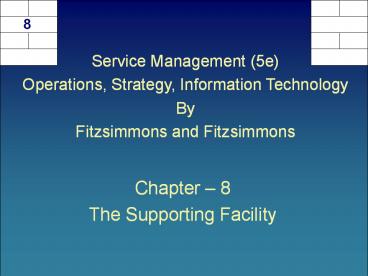Chapter - PowerPoint PPT Presentation
Title:
Chapter
Description:
Title: Service Facility Design and Layout Author: James Fitzsimmons Last modified by: Rajeev Sawhney Created Date: 1/31/1996 9:36:58 AM Document presentation format – PowerPoint PPT presentation
Number of Views:368
Avg rating:3.0/5.0
Title: Chapter
1
8
Service Management (5e) Operations, Strategy,
Information Technology By Fitzsimmons and
Fitzsimmons
- Chapter 8
- The Supporting Facility
2
Learning Objectives
- Discuss the impact of the servicescape on the
behavior of customers and employees. - Describe the critical facility design features.
- Draw a process flow diagram.
- Identify the bottleneck operation in a product
layout and rebalance for increased capacity. - Use operations sequence analysis to minimize
flow-distance in a process layout. - Recommend facility design features to remove
anxiety of disorientation.
3
Servicescapes
- Physical facility should be designed with an
image and feel that is congruent with the service
concept because the design of the physical
surroundings positively affect employee and
customer behavior. - The internal response measured cognitively,
emotionally, and physiologically is moderated by
ones personal mood. - A well conceived servicescape will encourage a
proper social interaction between and among
customers and employees
4
Environmental dimensions of servicescape
- Ambient Conditions background characteristics
such as noise level, music, lighting,
temperature, and scent. - Spatial Layout and Functionality reception
area, circulation paths of employees and
customers, and focal points. - Signs, Symbols, and Artifacts selection,
orientation, location, and size of objects.
5
Facility Design Considerations
- Nature and Objectives of Service Organization
- Land Availability and Space Requirements
- Flexibility
- Security
- Aesthetic Factors
- The Community and Environment
6
Signs used in flow chart
- Operation a rectangle encloses the operation
name and cycle time - Decision a diamond encloses the operation name
and cycle time - Wait a triangle represents customers waiting or
inventory of goods - Flow an arrow shows movement of customers,
goods, or information.
7
Process Analysis Terminology
- Cycle Time (CT) is the average time between
completions of successive units. - Bottleneck is the factor that limits production,
usually the slowest operation. - Capacity is a measure of output per unit time
when fully busy. - Capacity of an operation 1/CT
- Capacity of the entire system 1/bottleneck
capacity - Capacity Utilization is a measure of how much
output is actually achieved compared to the
process capacity.
8
Process Analysis Terminology (cont.)
- Throughput Time is the time to complete a process
from time of arrival to time of exit ( sum of
critical path average time in queues). - Rush Order Flow Time is the time to go through
the system without any queue time. - Direct Labor Content is the actual amount of work
time consumed. - Total Direct Labor Content is the sum of all the
operations times. - Direct Labor Utilization is a measure of the
percentage of time that workers are actually
contributing value to the service.
9
Process Flow Diagram of Mortgage Services
10
Product Layout Work Allocation Problem
- Automobile Drivers License Office
- Review Payment
Violations Eye Test
Photograph Issue - In
Out
11
Automobile Drivers License Office (Improved
Layout)
12
Process LayoutRelative Location Problem
- Ocean World Theme Park Daily Flows
13
Ocean World Theme Park (Proposed Layout)
- (a) Initial layout
(b) Move C close to A - Pair Flow
distances
Pair Flow distances - AC 30
2 60
CD 20 2 40 - AF 6
2 12
CF 8 2 16 - DC 20
2 40
DF 6 2 12 - DF 6
2 12
AF 6 2 12 - Total
124
CE 8 2 16 -
Total 96 - (c ) Exchange A and C
(d) Exchange B and E and move F
- Pair Flow
distances
Pair Flow distances - AE 15
2 30
AB 15 2 30 - CF 8
2 16
AD 0 2 0 - AF 6
2 12
FB 8 2 16 - AD 0
2 0
FD 6 2 12 - DF 6
2 12
Total 58
- Total
70
14
Environmental Orientation Considerations
- Need for spatial cues to orient visitors
- Formula facilities draw on previous experience
- Entrance atrium allows visitors to gain a quick
orientation and observe others for behavioral
cues - Orientation aids and signage such as You Are
Here maps reduce anxiety
15
Topics for Discussion
- Compare the attention to aesthetics in waiting
rooms that you have visited. How did the
different environments affect your mood? - Give an example of a servicescape that supports
the service concept and another that detracts.
Explain the success or failure in terms of the
servicescape dimensions. - Select a service and discuss how the design and
layout of the facility meets the five factors of
nature and objectives of the organization. - For Example 8.3, the Ocean World theme park, make
an argument for not locating popular attractions
next to each other. - The CRAAFT program is an example of a heuristic
programming approach to problem solving. Why
might CRAFT not find the optimal solution to a
layout problem?































